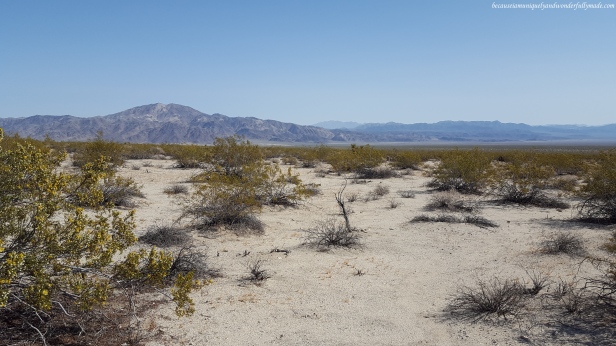From Saguaro National Park in Tucson, Arizona, we drove out to Joshua Tree National Park in California for 6 hours. With an approximate 800,000 acres of protected land area, Joshua Tree National Park is in the city of Twentynine Palms, about 2 hours east of Los Angeles.

WHERE TWO DESERTS MEET
Joshua Tree National Park is located where two distinct deserts converge. The western part of the Joshua Tree National Park lies in the Mojave Desert, while the eastern and southern portions are in the Colorado Desert, part of the Sonoran Desert. Each desert has an ecosystem whose characteristics are determined primarily by elevation. The Colorado Desert, which is below 3,000 feet elevation, covers the eastern part of the park and features natural gardens of creosote bush, ocotillo, and cholla cactus. The higher, moister, and slightly cooler Mojave Desert on the west is the ONLY place in the world where Joshua trees grow.
CAMPING and STARGAZING
My husband and I’s second camping experience is proudly at Cottonwood Campground at Joshua Tree National Park. The campsite is an easy access from Interstate 10. The campsite has a fire ring and picnic table, and drinking water and flush toilets are available nearby.
Upon arrival, I immediately wondered about the whereabouts of Joshua trees. I have not had any sight of any Joshua tree at all since we arrived. Apparently, it is because the Cottonwood Campground is situated in the Colorado desert! Rather than being surrounded by large rock formations and uniquely-shaped Joshua trees like the campgrounds in the northern section, where we were camped at was a flat, open-desert shrub land.
Joshua Tree National Park is also farther from towns or cities, which makes it a popular site for stargazing. The park’s elevation and the dry desert air makes it an excellent spot for observing the night sky. The sky darkness of this park is rated a Class 2–4 on the Bortle scale. The park was even honored with Dark Sky Park status by the International Dark-Sky Association.






JOSHUA TREE NATIONAL PARK
Driving through Joshua Tree National Park from east to west gave us an impressive perspective of how the landscape changed with the change in elevation. We witnessed how the scenery slowly changed from our Cottonwood campsite in the Colorado desert area which was flat and inhabited by mostly bushes, towards the Mojave desert section which is plenty of giant boulders and where Joshua trees thrive. How incredible that we have to spend a night camped at one desert, and play at a different desert the day after! What a beautiful world we live in!


Joshua Tree National Park is named for the Joshua trees (Yucca brevifolia) native to the park. They were named such because the outstretched tree limbs of a Joshua tree reminded the 19th-century Mormon settlers of a biblical story of Joshua reaching his hands to the sky. The Mormon settlers also felt the tree limbs guided them along their westward journey.
Joshua trees are not trees but are considered to be succulents. They are also commonly known as yucca palm, tree yucca, and palm tree yucca. In their dry ecosystems, however, they are considered trees of the desert. Joshua trees usually have a single trunk and grow three to nine feet (0.9 to 2.7 meters) tall before branching. Joshua trees do not have growth rings, a tree mark that indicates a year in the tree’s life. Joshua tree’s year are then roughly estimated based on their height as they grow at rates of one-half inch to three inches per year. Joshua tree’s average life span is about 150 years, but some largest trees may be much older than that.


















Surprisingly, one spot at Joshua Tree National Park that left an unforgettable impression on me is the Key’s View. It offers a panoramic view that takes in two of Southern California’s biggest summits: Mount San Jacinto and Mount Gorgonio. Coachella Valley can also be viewed in the background from Key’s Viewpoint. The Salton Sea, a lake formed when the Colorado River burst through poorly built irrigation controls south of Yuma, Arizona, shimmers to the southeast. It is also said that on a clear day, the Signal Mountain in Mexico can be seen from this viewpoint.
The push up of the San Andreas fault, the infamous fault stretching 700 miles from the Gulf of California to the Mendocino Coast north of San Francisco, can be also be seen below from Key’s View. Where we are standing at at the side of the valley, the North American tectonic plate, is moving south-east, and the other side, the Pacific plate, is sliding past it, heading north-west.
Do you understand now why this particular spot at Joshua Tree National Park left a lasting impression on me? SAN ANDREAS FAULT! This is what they show in movies that will destroy California, my home state!




After viewing the San Andreas fault, I was ready to leave. My husband didn’t mind. Afterall, it was past noon and we were starting to starve.




***

Nice! On my bucket list 😃
Joshua trees are very unusual and are not like any other type of plant we have ever seen. Very nice post!
Thank you Armann and Kaymann! I particularly love how beautiful Joshua trees look with the giant boulders in the background. The stargazing was also a huge plus. 😍
Welcome to camping! I love camping. I am glad to live outside the town, with a darker sky than many; seeing the stars is wonder and delight. Thank you for sharing.